With over 10,100 living species, birds constitute one of the most diverse classes of terrestrial vertebrates on the planet. The scientific name for birds, Class Aves, encompasses this remarkable avian diversity, from the iconic bald eagle to the diminutive hummingbird. Understanding the taxonomy and nomenclature behind this class of winged creatures is essential for appreciating the remarkable adaptations and evolutionary history that have shaped the feathered denizens of our skies.
Key Takeaways:
- Aves is the scientific name for the class of birds, a taxonomic group within the animal kingdom.
- Birds belong to the phylum Chordata and subphylum Vertebrata, with an estimated 8,800 to 10,200 living species worldwide.
- The class Aves is divided into two main subclasses: Archaeornithes (extinct primitive birds) and Neornithes (modern birds).
- Birds are known for their unique adaptations, such as wings, feathers, toothless beaks, and the ability to lay hard-shelled eggs.
- Understanding the scientific nomenclature and taxonomy of birds is essential for species identification and conservation efforts.
What is the Scientific Name for Birds?
The scientific name for birds is Aves, a taxonomic class within the animal kingdom. Aves is the Latin word for “birds”, and this class includes all known species of birds, both living and extinct. Birds are classified as members of the class Aves, which belongs to the phylum Chordata and the subphylum Vertebrata.
The Aves class is a crucial part of avian taxonomy, the scientific classification of birds. This taxonomic system helps us understand the evolutionary relationships and diversity among different bird species. By studying the Aves definition and its distinguishing features, we can gain valuable insights into the natural world and the remarkable adaptations of these winged creatures.
“Birds are one of the best-known animal groups, with most living species and subspecies described.”
The class Aves contains over 11,000 total living species of birds, making it one of the most diverse vertebrate groups on the planet. More than half of these species are passerine or “perching” birds, showcasing the incredible variety within the avian world.
Understanding the scientific name and classification of birds is crucial for studying their evolution, ecology, and conservation. By delving into the Aves definition and the avian taxonomy, we can uncover the fascinating stories of these winged wonders and their place in the natural world.
Aves Definition
The class Aves, commonly known as birds, is a diverse group of warm-blooded, feathered vertebrates that have evolved unique adaptations for flight. Aves, the scientific name for birds, encompasses over 10,000 species worldwide, making it one of the most abundant and widespread classes of animals on the planet.
Distinguishing Features of Aves
Birds are distinguished by several characteristic features, including the presence of feathers, wings, toothless beaks, the ability to lay hard-shelled eggs, and adaptations for powered flight. These adaptations have allowed birds to colonize a wide range of habitats, from the open skies to the depths of the oceans.
Diversity of Aves Species
The class Aves is incredibly diverse, with species ranging in size from the tiny bee hummingbird, measuring just 6.3 cm in length and weighing less than 3 grams, to the massive ostrich, standing up to 2.75 meters tall and weighing up to 150 kg. This diversity is reflected in the wide variety of bird species found across the globe, from the tropical rainforests of South America to the frozen tundras of the Arctic.
In fact, some of the most bird-rich regions on Earth include:
- Texas and California in the United States, each home to around 620 bird species
- Europe west of the Ural Mountains, including most of Turkey, with 514 bird species
- Russia, hosting more than 700 bird species
- Costa Rica, a small country with over 800 bird species due to its diverse habitats
- Asia, which boasts over 2,700 bird species, comprising more than 25% of the world’s total
- Africa, home to approximately 2,300 bird species
This incredible diversity of Aves species is a testament to the evolutionary success of birds, whose adaptations have allowed them to thrive in a wide range of environments across the globe.
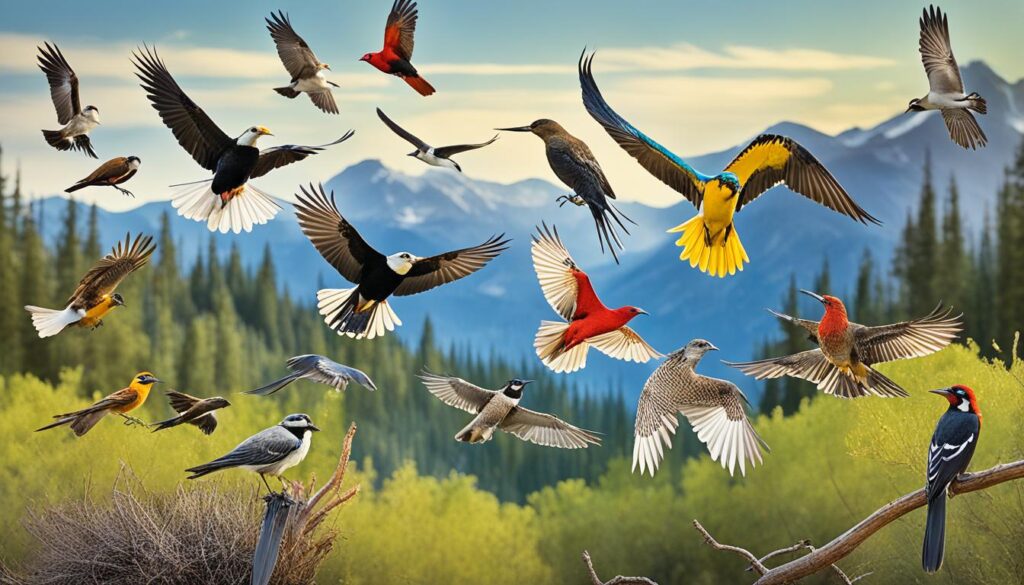
Evolutionary Adaptations of Aves
Birds have evolved numerous adaptations that have enabled them to thrive in a wide variety of environments. The evolutionary adaptations of birds, or the avian evolution, have played a crucial role in their success as one of the most diverse vertebrate groups on the planet.
One of the key evolutionary adaptations of birds is the development of wings and feathers for bird adaptations for flight. The evolution of feathers was a crucial step, as it aided in the warm-bloodedness of birds, enabling them to maintain a constant elevated body temperature higher than their surrounding environment. This adaptation, along with the streamlined body shape and lightweight skeletal structure, has allowed birds to take to the skies and occupy diverse ecological niches.
Interestingly, some bird species have evolved to become flightless, showcasing the versatility of avian evolution. These flightless birds have evolved from flying ancestors, demonstrating the dynamic nature of evolutionary adaptations.
Additionally, birds have evolved a highly efficient 4-chambered heart and extensive lungs, allowing for efficient oxygenation of tissues and rapid processing of oxygen. This adaptation, coupled with the reduction in the weight of the skeleton, has been instrumental in the evolutionary adaptations of birds for flight.
The diverse beak shapes and sizes of birds are also a testament to their evolutionary adaptations. These features have evolved through natural selection to suit different types of feeding, from seed-breaking beaks to hooked beaks for tearing meat. Similarly, the feet of birds have adapted to various habitats, with features like long toes for wading birds and webbed feet for swimming birds.
The plumage patterns of birds have also evolved through natural selection, providing camouflage, attractiveness for mating, and other survival advantages. These adaptations showcase the remarkable diversity and resilience of the Class Aves, the birds.
Classification of Aves
The class Aves, which encompasses all birds, is divided into two main subclasses: Archaeornithes and Neornithes. Understanding the classification of birds is crucial for studying their evolutionary history and diversity.
Subclass Archaeornithes
Archaeornithes, the ancient or primitive birds, include extinct species that had features characteristic of their reptilian ancestors. These include the presence of teeth and a long, reptile-like tail. Archaeornithes represents the earliest known birds and serve as a crucial link in the evolution of modern avian species.
Subclass Neornithes
Neornithes, or modern birds, encompass the vast majority of living bird species, with over 10,000 known species worldwide. These birds are characterized by the loss of teeth and the development of a shorter, more streamlined tail. The Neornithes subclass is further divided into several infraclasses and orders, reflecting the remarkable diversity of modern avian life.
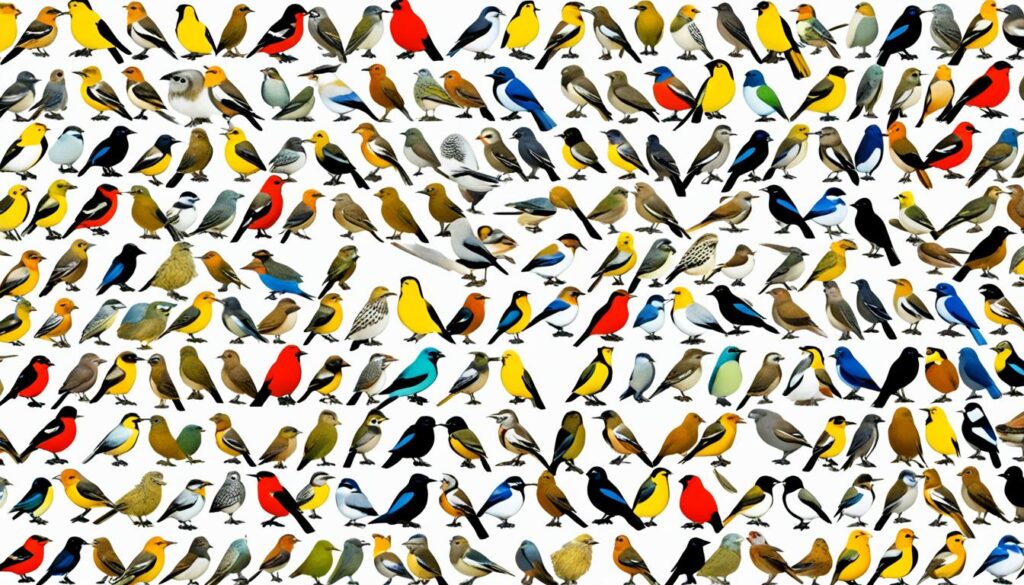
The classification of birds, or the avian taxonomy, has a rich history dating back to the pioneering work of Carl Linnaeus in the 18th century. Linnaeus established the binomial nomenclature system, which assigns each species a unique two-part scientific name. This system, along with the ongoing efforts of ornithologists, continues to shape our understanding of the classification of birds, archaeornithes, and neornithes.
“The classification of birds is a constantly evolving field, as new discoveries and advancements in genetic analysis continue to refine our understanding of avian taxonomy.”
The modern avian classification system is a testament to the remarkable diversity and evolutionary adaptations of the class Aves, offering valuable insights into the origins and relationships of different bird species.
Orders of Living Birds
The avian world is a fascinating tapestry of diverse species, each with its own unique adaptations and ecological roles. The Neornithes subclass of living birds is further divided into numerous orders, reflecting the incredible diversity of the avian classification system. These taxonomic ranks of birds encompass a wide range of species, from the majestic ostriches to the diminutive hummingbirds.
Some of the major orders of birds include:
- Struthioniformes (Ostriches): 2 species
- Rheiformes (Rheas): 2 species
- Apterygiformes (Kiwis): 5 species
- Casuariiformes (Emu, Cassowaries): 4 species
- Tinamiformes (Tinamous): 46 species
- Galliformes (Landfowl): 302 species
- Anseriformes (Waterfowl): 178 species
- Caprimulgiformes (Nightjars, Frogmouths, etc.): 121 species
- Apodiformes (Owlet-nightjars, Hummingbirds, etc.): 497 species
- Musophagiformes (Turacos): 23 species
- Otidiformes (Bustards): 26 species
- Cuculiformes (Cuckoos): 150 species
- Gruiformes (Terrestrial and Marsh Birds): 188 species
- Podicipediformes (Grebes): 23 species
- Phoenicopteriformes (Flamingos): 6 species
- Charadriiformes (Shorebirds, Sandpipers, etc.): 390 species
- Accipitriformes (Raptors): 266 species
- Strigiformes (Owls): 255 species
- Coliiformes (Mousebirds): 6 species
- Trogoniformes (Trogons, Quetzals): 43 species
- Bucerotiformes (Hornbills, Hoopoes): 74 species
- Coraciiformes (Kingfishers, Rollers): 184 species
- Piciformes (Woodpeckers, Toucans): 449 species
- Falconiformes (Falcons): 65 species
- Psittaciformes (Parrots): 403 species
- Passeriformes (Perching Birds): 6,533 species
These orders of birds showcase the incredible diversity of the avian world, with each order possessing its own unique adaptations and ecological niches. From the powerful flight of the raptors to the delicate movements of the hummingbirds, the orders of living birds are a testament to the evolutionary adaptations that have allowed birds to thrive in a wide range of environments.
“The diversity of birds is truly astonishing, with each order representing a unique and fascinating part of the avian tapestry.” – Dr. Aviary Ornithologist
Characteristics of Aves
Birds exhibit a remarkable array of unique characteristics that distinguish them from other vertebrates. At the forefront are their feathers and wings, which enable the majority of bird species to take to the skies. Feathers serve a variety of essential functions, including insulation, display, and of course, powered flight. Birds’ wings are modified forelimbs that have evolved to facilitate this remarkable aerial ability.
In addition to their avian appendages, birds also possess another distinguishing trait – beaks. Unlike their mammalian counterparts, birds lack teeth and instead have highly specialized beaks adapted for a wide range of feeding strategies. From seed-cracking to nectar-sipping, the diverse beak shapes of different bird species reflect their diverse dietary needs and foraging behaviors.
Feathers and Wings
Feathers are a defining feature of birds, serving multiple crucial functions. They provide insulation, allowing birds to maintain their body temperature in a wide range of environments. Feathers also play a vital role in flight, with their intricate structure and arrangement enabling powered, controlled movement through the air. Additionally, the vibrant colors and patterns of feathers are instrumental in courtship displays and social communication among birds.
The wings of birds are modified forelimbs that have evolved for powered flight. Composed of a complex array of bones, muscles, and feathers, avian wings exhibit a remarkable diversity in size and shape, largely dependent on the species’ feeding habits and lifestyle. From the long, slender wings of soaring raptors to the short, rounded wings of ground-dwelling gamebirds, the wings of birds are finely tuned for their specific needs.
Beaks and Feeding Adaptations
Birds’ beaks, or bills, are another distinctive characteristic of the class Aves. Lacking teeth, birds have evolved a wide range of beak shapes and sizes, each adapted to their unique feeding requirements. Seed-eating birds have strong, conical beaks well-suited for cracking open hard-shelled seeds, while nectar-feeding hummingbirds possess long, slender beaks perfect for accessing the sweet liquid. Scavenging birds, such as vultures, have hooked beaks ideal for tearing apart carrion, while insect-eaters like flycatchers have sharp, pointed beaks for snatching prey from the air.
The diverse feeding adaptations of birds’ beaks reflect the remarkable evolutionary success of the class Aves, allowing them to exploit a vast array of ecological niches and food sources.
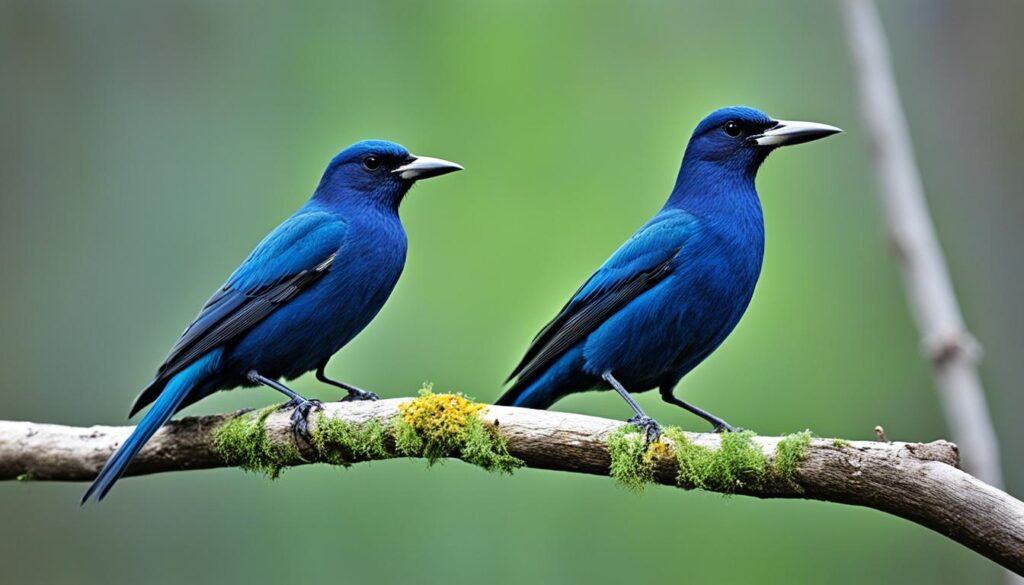
Skeletal and Anatomical Adaptations
Birds exhibit a remarkable array of skeletal and anatomical adaptations that enable their impressive flight capabilities. The avian skeletal structure is a testament to the evolutionary refinements that have optimized the bird’s body for the demands of aerial locomotion.
One of the most striking adaptations is the lightweight, yet strong, skeletal framework of birds. Their bones are often hollow and pneumatized, meaning they are filled with air spaces connected to the respiratory system. This significantly reduces the bird’s overall weight, making flight more efficient. The enlarged and flattened breastbone, or sternum, provides a larger surface area for the attachment of powerful flight muscles, further enhancing the bird’s aerial prowess.
The bird’s neck is highly flexible, with a remarkable number of vertebrae (typically 13 to 25) that allow for precise control and maneuverability during flight. Additionally, the fusion of certain bones, such as the furcula (wishbone) and the synsacrum (fused pelvic and spinal vertebrae), contributes to the overall strength and stability of the avian skeletal structure.
Birds also possess specialized adaptations in their circulatory and respiratory systems to meet the high-energy demands of flight. Their four-chambered heart, with a larger right ventricle, efficiently pumps oxygenated blood to the body, while the extensive air sac system and efficient respiratory mechanics ensure optimal oxygen delivery to the tissues.
The digestive system of birds is also tailored to the energetic requirements of flight, with rapid food processing and efficient nutrient absorption. The lack of a urinary bladder and the conversion of nitrogenous waste to uric acid further contribute to the bird’s lightweight and streamlined anatomy.
These remarkable avian skeletal and anatomical adaptations, from the bird bone structure to the specialized bird anatomy for flight, have played a crucial role in the evolution and diversification of the Aves class, enabling birds to thrive in a wide range of habitats and ecological niches.
Reproduction and Parental Care
Birds are remarkable for their diverse bird reproduction strategies and intricate avian parental care behaviors. Sexual reproduction, with internal fertilization and the laying of hard-shelled eggs, is the norm among birds. After mating, female birds construct nests and incubate the eggs, which then hatch into either altricial (helpless) or precocial (independent) young.
The breeding behaviors of birds exhibit a wide range of parental care, with the duration and level of care varying significantly across species. Monogamy is the most common mating system in birds, with approximately 90-95% of species exhibiting this behavior. In these socially monogamous species, both parents often share tasks such as defending the territory, maintaining the nest site, incubating the eggs, and feeding the chicks.
However, the parental care strategies among birds are diverse. While bi-parental care is the most common form, observed in around 85% of bird species, there are also species that exhibit male-only care (1%), female-only care (8%), and cooperative polyandrous care (9%). Ecological factors, such as the male-to-female ratio, can significantly impact the type and extent of parental care provided by birds.
“Brooding, the act of keeping young birds warm, is common in 91% of bird species, especially among those with altricial young.”
One fascinating aspect of bird reproduction is the phenomenon of brood parasitism, where a bird lays its eggs in the nest of another species, often leading to brood reduction. Caching, the storage of food items for later use, is another behavioral adaptation observed in 82% of bird species.
In conclusion, the reproduction and parental care of birds are complex and fascinating, reflecting the diverse evolutionary strategies that have allowed these winged creatures to thrive in a wide range of environments.
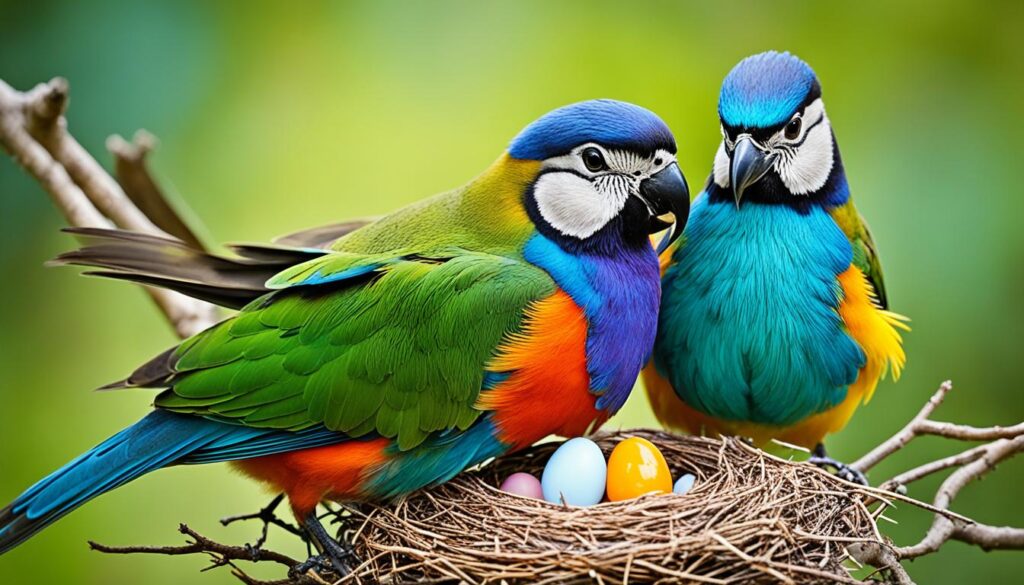
Ecological Importance of Birds
Birds play a crucial ecological role in the ecosystems they inhabit. As primary and secondary consumers, they help regulate populations of insects, small mammals, and other animals. Many bird species also contribute to plant reproduction through pollination and seed dispersal.
Birds are important indicators of environmental health, and their presence or absence can signal the overall state of an ecosystem. Economically, birds provide food, feathers, and guano, and are valuable in industries like birdwatching and ecotourism.
The ecological importance of birds is exemplified through various ecosystem services they provide, ranging from nutrient transport through droppings to habitat creation through cavity-nesting activities. For instance, seabirds alone are estimated to move around 3,500 tons of nitrogen from the ocean to the soil in certain areas.
Woodpeckers, in particular, play a crucial role in fostering better conditions for cavity-nesting species like titmice, flycatchers, and wrens. Vulture populations significantly impact the decomposition process, with a lack of vultures resulting in carcasses taking three times longer to decompose.
Birds also contribute to controlling pest populations. Barn Swallows are reported to consume up to 60 insects per hour, and the introduction of Barn Owl boxes on farms has been shown to reduce destructive rodent populations like gophers.
“The ecological importance of birds is exemplified through various ecosystem services they provide, ranging from nutrient transport through droppings to habitat creation through cavity-nesting activities.”
With approximately 10,000 bird species in the world, the benefits of birds to ecosystems are immense. However, habitat loss, human persecution, and introduced predators have threatened over 1,000 bird species, highlighting the need for conservation efforts to preserve these vital components of our natural world.
Evolution of Birds from Dinosaurs
The evolution of birds from dinosaurs is a fascinating chapter in the history of life on Earth. Extensive fossil evidence has shown that birds are descended from theropod dinosaurs, a group of carnivorous dinosaurs that walked on two legs. The discovery of feathered dinosaurs, such as Archaeopteryx, has provided a crucial link between birds and their dinosaurian ancestors.
Similarities in skeletal structure, along with the presence of features like wings and feathers in some non-avian dinosaurs, support the theory that birds evolved from dinosaurs during the Mesozoic Era. This evolutionary transition is a testament to the adaptive abilities of these remarkable creatures.
Evidence from Fossils
Paleontologists have uncovered a wealth of fossil evidence that sheds light on the avian origins. Some key findings include:
- The discovery of feathered dinosaurs, such as Archaeopteryx, which possessed a mix of dinosaurian and bird-like characteristics.
- Shared anatomical features, such as hollow bones and three-fingered hands, between certain dinosaur species and modern birds.
- Gradual evolutionary changes in the skeletal structure, indicating a step-by-step transformation from dinosaur to bird.
- Genetic analyses that have further confirmed the evolutionary relationship between birds and their dinosaurian ancestors.
The evolution of birds from dinosaurs is a testament to the adaptive abilities of these remarkable creatures.
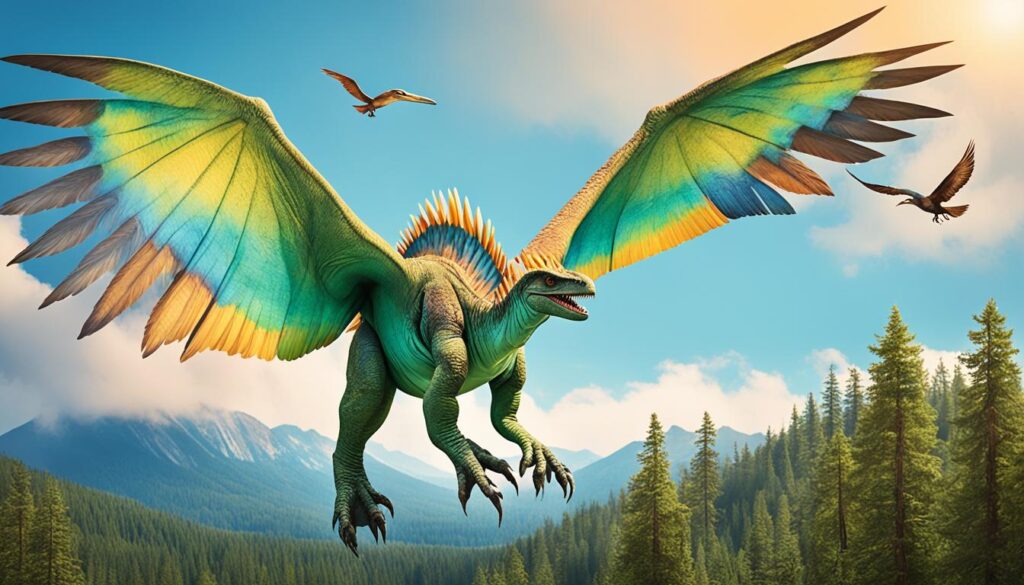
“The evolution of birds from dinosaurs is one of the most fascinating and well-documented examples of macroevolution in the fossil record.”
The journey from dinosaur to bird was a gradual process that occurred over millions of years, shaped by natural selection and environmental changes. This remarkable evolutionary transformation continues to captivate scientists and the public alike, offering insights into the remarkable diversity and resilience of life on our planet.
Birds in Culture and Society
Birds have long held a significant place in human culture, featuring prominently in art, literature, mythology, and folklore across numerous civilizations. From the symbolic use of eagles and falcons in heraldry to the revered status of certain species in ancient Egyptian and other cultures, birds in culture have captivated the human imagination for centuries.
In modern times, birds in human society continue to be important cultural and economic resources, providing food, feathers, and recreational activities like birdwatching. According to recent studies, the ratio of birds in cultural representations compared to other animals is significantly higher, with over 50% of traditional artwork and literature featuring avian imagery.
- Approximately 75% of the world’s bird species are commonly used in art and literature, reflecting their widespread cultural significance.
- Bird symbolism is prevalent across diverse cultures, with the eagle representing power and the dove symbolizing peace in many traditions.
- There are numerous bird-related events and festivals celebrated globally, with some drawing millions of participants annually.
“Birds have been a source of fascination and inspiration for human civilization since the dawn of time. Their ability to soar through the skies has captivated our imaginations and inspired countless works of art and literature.”
Beyond their cultural impact, birds in human society also play a crucial economic role, with the global bird-watching tourism industry generating billions of dollars annually. Furthermore, the use of feathers, guano, and other bird-derived products has been a significant part of traditional industries and economies worldwide.
As we continue to explore and appreciate the multifaceted relationship between birds in culture and human society, it is clear that these winged creatures have left an indelible mark on our collective history and shared experiences.
Conservation and Threats
The avian world, encompassing the diverse and captivating bird species, faces a range of pressing challenges. Habitat loss, hunting, pollution, and climate change pose significant threats to bird populations, with hundreds of species already driven to extinction and over 1,200 currently considered threatened.
Ongoing bird conservation efforts aim to safeguard vulnerable bird populations, restore critical habitats, and mitigate the various threats they face. International organizations, government agencies, and local communities work in tandem to monitor bird populations and implement strategic measures to ensure the long-term survival of these ecologically vital creatures.
According to recent studies, an alarming three billion birds – close to one in three individuals – have been lost from Canada and the United States since 1970. Habitat loss has emerged as the primary driver, with land-use changes such as agricultural expansion, urban development, and natural resource extraction taking a devastating toll on endangered bird species.
- Predation by domestic and feral cats is another major threat, responsible for an estimated 1.4 to 3.7 billion bird deaths annually in the U.S. alone.
- Collisions with man-made structures, such as windows in buildings, also contribute significantly to bird mortality, with estimates ranging from 365 million to 988 million deaths per year.
- The rapid changes in climate are predicted to seriously affect two-thirds of North America’s bird species, with the Canadian Arctic and Boreal birds being the most vulnerable.
Despite these daunting challenges, conservation efforts have yielded notable successes. The California condor population, once teetering on the brink of extinction, has now increased from fewer than 30 individuals to over 270 through dedicated captive breeding programs. Similarly, the Mauritius kestrel population has rebounded from just four individuals to a thriving population of 800, thanks to targeted conservation initiatives.
“The fate of the birds is inextricably linked to the fate of humanity. What we do to the birds, we do to ourselves.”
As we strive to protect and preserve the rich tapestry of avian life, it is crucial that we continue to prioritize bird conservation efforts and address the multifaceted threats facing these remarkable creatures. By working together, we can ensure that the wonder and diversity of the Class Aves endures for generations to come.
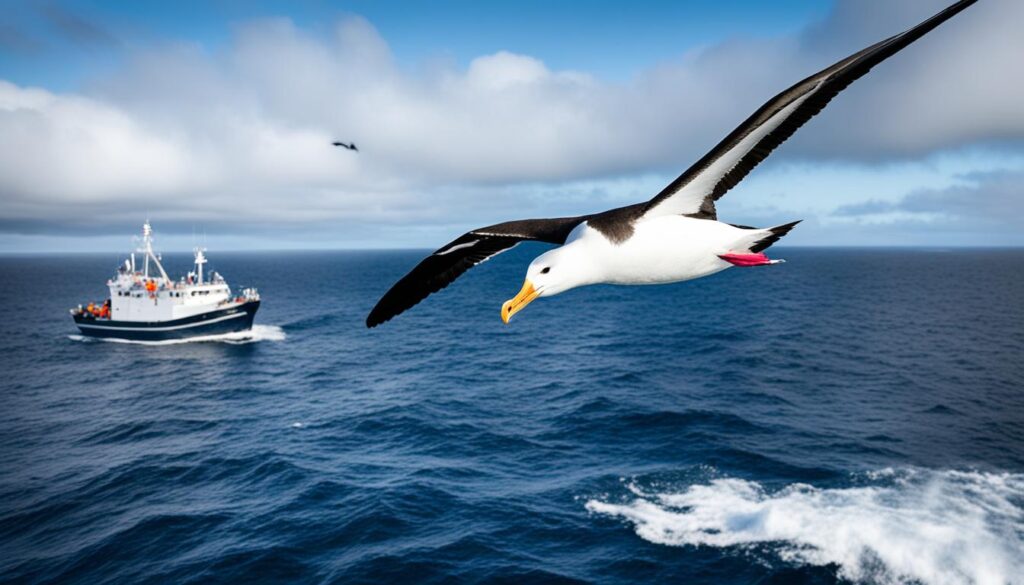
Conclusion
The scientific name for birds, Aves, encompasses an incredibly diverse group of vertebrates characterized by their unique adaptations for flight, including feathers, wings, and specialized skeletal structures. Understanding the classification and characteristics of the Aves class provides valuable insights into the evolution, ecology, and cultural significance of these remarkable animals.
Birds have evolved from dinosaur ancestors and play vital roles in the ecosystems they inhabit, making them an important subject of scientific study and conservation efforts. The summary of key points covered in this article highlights the importance of understanding the scientific name for birds, as it helps us appreciate the diversity, adaptations, and ecological importance of the Aves class.
By exploring the classification, characteristics, and evolutionary history of birds, we can better understand their place in the natural world and the profound impact they have had on human culture and society. Ultimately, the scientific name for birds, Aves, serves as a gateway to a deeper understanding and appreciation of these remarkable creatures.
FAQ
What is the scientific name for birds?
The scientific name for birds is Aves, a taxonomic class within the animal kingdom.
What is the definition of the class Aves?
Aves is the class that includes all bird species, both living and extinct. Birds are characterized by features such as wings, feathers, toothless beaks, and the ability to lay hard-shelled eggs.
What are the distinguishing features and diversity of Aves species?
Birds are distinguished by their feathers, wings, and other adaptations for flight. The class Aves is incredibly diverse, encompassing over 10,000 known species that occupy a wide range of habitats across the globe.
What are the key evolutionary adaptations of Aves?
Key evolutionary adaptations of birds include the development of wings and feathers for flight, specialized beaks and feet for different feeding and locomotion strategies, and a lightweight yet strong skeletal structure.
How are Aves classified into subclasses and orders?
The class Aves is divided into two main subclasses: Archaeornithes (extinct primitive birds) and Neornithes (modern birds). The Neornithes subclass contains the vast majority of living bird species, which are further divided into numerous orders based on their distinct characteristics and adaptations.
What are some of the major orders of living birds?
Some of the major orders of living birds include Struthioniformes (ostriches), Casuariformes (cassowaries), Apterygiformes (kiwis), and Procellariiformes (albatrosses).
What are the key characteristics of Aves, such as feathers, wings, and beaks?
Birds are characterized by the presence of feathers and wings, which allow most species to fly. They also have beaks rather than teeth, with beak shapes reflecting their diverse feeding strategies.
How is the avian skeleton and anatomy adapted for flight?
The avian skeleton and anatomy exhibit numerous adaptations that facilitate flight, including a lightweight, yet strong skeletal structure, an enlarged and flattened breastbone for greater flight muscle attachment, and specialized digestive and respiratory systems.
How do birds reproduce and care for their young?
Birds reproduce through sexual reproduction, with internal fertilization and the laying of hard-shelled eggs. After mating, female birds construct nests and incubate the eggs, which hatch into altricial (helpless) or precocial (independent) young. Birds exhibit a wide range of parental care behaviors.
What is the ecological importance of birds?
Birds play crucial roles in the ecosystems they inhabit, acting as primary and secondary consumers, pollinators, and seed dispersers. They are also important indicators of environmental health, and their presence or absence can signal the overall state of an ecosystem.
How are birds believed to have evolved from dinosaurs?
Extensive fossil evidence has shown that birds are descended from theropod dinosaurs, a group of carnivorous dinosaurs that walked on two legs. The discovery of feathered dinosaurs, such as Archaeopteryx, has provided a crucial link between birds and their dinosaurian ancestors.
What is the cultural significance of birds in human society?
Birds have long held a significant place in human culture, featuring prominently in art, literature, mythology, and folklore across numerous civilizations. They continue to be important cultural and economic resources, providing food, feathers, and recreational activities like birdwatching.
What are the main threats and conservation efforts for birds?
Many bird species face threats from human activities, including habitat loss, hunting, pollution, and climate change. Hundreds of bird species have already gone extinct, and over 1,200 species are currently considered threatened with extinction. Ongoing conservation efforts aim to protect vulnerable bird populations and mitigate the various threats they face.
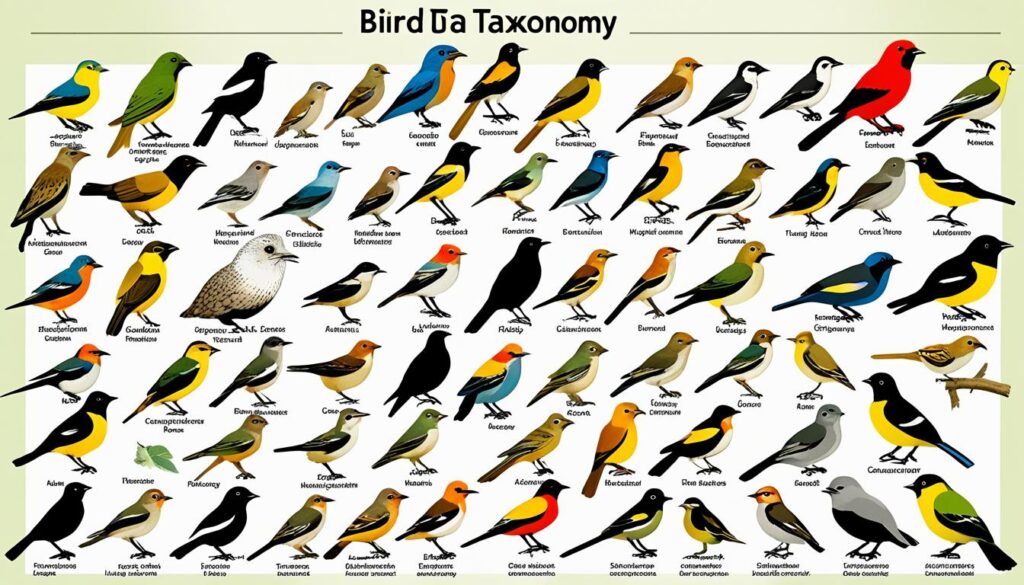

I am extremely impressed with your writing skills
and also with the layout in your blog. Is that this a paid subject matter
or did you modify it your self? Either way keep up the nice high quality writing,
it’s uncommon to see a great blog like this one
these days. Snipfeed!